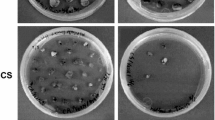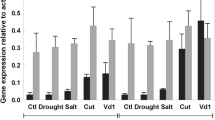Abstract
Although the hypersensitive reaction in foliar plant diseases has been extensively described, little is clear regarding plant defense strategies in vascular wilt diseases affecting numerous economically important crops and trees. We have examined global genetic responses to Verticillium wilt in tomato (Lycopersicon esculentum Mill.) plants differing in Ve1 resistance alleles. Unexpectedly, mRNA analyses in the susceptible plant (Ve1−) based on the microarrays revealed a very heroic but unsuccessful systemic response involving many known plant defense genes. In contrast, the response is surprisingly low in plants expressing the Ve1+ R-gene and successfully resisting the pathogen. Similarly, whole-cell protein analyses, based on 2D gel electrophoresis and mass spectrometry, demonstrate large systemic increases in a variety of known plant defense proteins in the stems of susceptible plants but only modest changes in the resistant plant. Taken together, the results indicate that the large systemic increases in plant defense proteins do not protect the susceptible plant. Indeed, since a number of the highly elevated proteins are known to participate in the plant hypersensitive response as well as natural senescence, the results suggest that some or all of the disease symptoms, including ultimate plant death, actually may be the result of this exaggerated plant response.






Similar content being viewed by others
Abbreviations
- CS cv:
-
Craigella susceptible
- CR cv:
-
Craigella resistant
- d.p.i:
-
Days post-inoculation
- HR:
-
Hypersensitive response
- IPG:
-
Immobilized pH gradient isoelectric focusing
- MALDI-MS:
-
Matrix-assisted laser desorption/ionization-mass spectrometry
- MMLV:
-
Maloney murine leukemia virus
- pAP3:
-
32P-labeled anionic potato peroxidase
- PR:
-
Pathogenesis-related
- R-gene:
-
Resistance-gene
- SAR:
-
Systemic acquired resistance
- SDS:
-
Sodium dodecylsulphate
- TVR:
-
Tomato Verticillium response
- Vd1:
-
Verticillium dahliae, race 1
References
Alba R, Fei Z, Payton P, Liu JM, Moore SL, Debbie P, Cohn J, D’Ascenzo M, Gordon JS, Rose JK, Martin G, Tanksley SD, Bouzayen M, Jahn M, Giovannoni J (2004) EST’s, cDNA microarrays, and gene expression profiling: tools for dissecting plant physiology and development. Plant J 39:697–714
Beckman CH (1987) The nature of wilt diseases of plants. APS Press, St. Paul, pp 36–64
Bernards MA, Fleming WD, Llewellyn DB, Priefer R, Yang X, Sabatino A, Plourde GL (1999) Biochemical characterization of the suberization-associated anionic peroxidase gene of potato. Plant Physiol 121:135–146
Bishop CD, Cooper RM (1983) An ultrastructural study of root invasion in three vascular wilt diseases. Physiol Plant Pathol 22:15–27
Buchanan-Wollaston V, Earl S, Harrison E, Mathas E, Navabpour S, Page T, Pink D (2003) The molecular analysis of leaf senescence—a genomics approach. Plant Biotech J 1:3–22
Busch LV, Smith E (1981) Susceptibility of Ontario-grown alflafa cultivars and certain Medicago species to Verticillium albo-atrum. Can J Plant Pathol 3:169–172
Castroverde CDM, Nazar RN, Robb J (2010) Defence genes in tomato. In: Aube ED, Poole FM (eds) Tomatoes: agricultural practices, pathogen interactions and health effects. Nova Science Publishers Inc, Hauppauge, pp 1–40
Chen P, Lee B, Robb J (2004) Tolerance to a non-host isolate of Verticillium dahliae in tomato. Physiol Mol Plant Pathol 64:283–291
Dobinson KF, Tenuta GK, Lazarovits G (1996) Occurrence of race 2 of Verticillium dahliae in processing fields in southwestern Ontario. Can J Plant Pathol 18:55–58
Durrant WE, Dong X (2004) Systemic acquired resistance. Annu Rev Phytopathol 42:185–209
Flor HH (1971) Current status of the gene-for-gene concept. Annu Rev Phytopathol 9:275–296
Fradin EF, Thomma BP (2006) Physiology and molecular aspects of Verticillium wilt diseases caused by V. dahliae and V. albo-atrum. Mol Plant Pathol 7:71–86
Fradin EF, Zhang Z, Juarez-Ayala Castroverde CDM, Nazar RN, Robb J, Liu C-M, Thomma BPHJ (2009) Genetic dissection of Verticillium wilt resistance mediated by tomato Ve1. Plant Physiol 150:320–332
Gayoso C, Pomar F, Novo-Uzal E, Merino F, de Ilárduya OM (2010) The Ve-mediated resistance response of the tomato to Verticillium dahliae involves H2O2, peroxidase and lignins and drives PAL gene expression. BMC Plant Biol 10:232–250
Gold J, Robb J (1995) The role of the coating response in Craigella tomatoes infected with Verticillium dahliae, races 1 and 2. Physiol Mol Plant Pathol 47:141–157
Hu X, Nazar RN, Robb J (1993) Quantification of Verticillium biomass in wilt disease development. Physiol Mol Plant Pathol 42:23–36
Hurkman WJ, Tanaka CK (1986) Solubilization of plant membrane proteins for analysis by two-dimensional gel electrophoresis. Plant Physiol 81:802–806
Kawchuk L, Hachey J, Lynch DR, Klcsar F, van Rooijen G, Waterer DR, Robertson A, Kokko E, Byers R, Howard RJ, Fischer R, Prufer D (2001) Tomato Ve disease resistance genes encode cell surface-like receptors. Proc Natl Acad Sci USA 98:6511–6515
Lam E (2004) Controlled cell death, plant survival and development. Nat Rev/Mol Cell Biol 5:305–315
Lam E, Kato N, Lawton M (2001) Programmed cell death, mitochondria and the plant hypersensitive response. Nature 411:848–853
Mittler R, Cheung AY (2004) Cell death in plant development and defense. In: Lockshin RA, Zakeri Z (eds) When cells die II: a comprehensive evaluation of apoptosis and programmed cell death. Wiley, Hoboken, pp 99–122
Pegg GF (1981) Biochemistry and physiology of pathogenesis. In: Mace ME, Bell AA, Beckman CH (eds) Fungal wilt diseases of plants. Academic Press Inc, USA
Pegg GF, Brady BL (2002) Verticillium wilts, 1st edn. CABI Publishing, Wallingford, pp 193–253
Pegg GF, Street PFS (1984) Measurement of Verticillium albo-atrum in high and low resistance hop cultivars. Trans British Mycol Soc 82:99–106
Powelson ML, Rowe RC (1993) Biology and management of early dying of potatoes. Annu Rev Phytopathol 31:111–126
Quirino BF, Noh Y-S, Himelblau E, Amasino RM (2000) Molecular aspects of leaf senescence. Trends Plant Sci 5:278–282
Robb J, Busch LV (1983) Structure and significance of “blocked” veins in Verticillium-infected chrysanthemum. Physiol Plant Pathol 23:35–53
Robb EJ, Nazar RN (1996) Factors contributing to successful PCR-based diagnostics for potato and other crops. In: Marshall G (ed) Diagnostics in crop production. British Crop Protection Council, Surrey, pp 75–84
Robb EJ, Street PFS, Busch LV (1983) Basic fuchsin: a vascular dye in studies of Verticillium-infected chrysanthemum and tomato. Can J Bot 61:3355–3365
Robb EJ, Powell DA, Street PFS (1989) Vascular coating: a barrier to colonization by the pathogen in Verticillium wilt of tomato. Can J Bot 67:600–607
Robb EJ, Lee S-W, Mohan R, Kolattukudy PE (1991) Chemical characterization of stress-induced vascular coating in tomato. Plant Physiol 97:528–536
Robb J, Castroverde CDM, Shittu HO, Nazar RN (2009) Patterns of defence gene expression in the tomato-Verticillium interaction. Botany 87:993–1006
Sambrook J, Russell DW (2001) Molecular cloning: a laboratory manual. Cold Spring Harbor Laboratory Press, Cold Spring Harbor
Savoie CJ, Aburatani S, Watanabe S, Eguchi Y, Muta S, Imoto S, Miyano S, Kuhara S, Tashiro K (2003) Use of gene networks from full genome microarray libraries to identify functionally relevant drug-affected genes and gene regulation cascades. DNA Res 10:19–25
Schaible L, Cannon OS, Waddoups V (1951) Inheritance of resistance to Verticillium wilt in a tomato cross. Phytopathol 41:986–990
Shittu HO, Castroverde CDM, Nazar RN, Robb J (2009) Plant-endophyte interplay protects tomato against a virulent Verticillium. Planta 229:415–426
Straub C, Pazdrak K, Young TW, Stafford SJ, Wu Z, Je Wiktorowiczm, Haag AM, English RD, Soman KV, Kurosky A (2009) Toward the proteome of the human peripheral blood eosinophil. Proteomics Clin Appl 3:1151–1173
Street PFS, Robb J, Ellis BE (1986) Secretion of vascular coating components by xylem parenchyma cells of tomatoes infected with Verticillium albo-atrum. Protoplasma 132:1–11
Tabaeizadeh Z, Agharbaoui Z, Harrak H, Poysa V (1999) Transgenic tomato plants expressing a Lycopersicon chilense chitinase gene demonstrate improved resistance to Verticillium dahliae race 2. Plant Cell Rep 19:197–202
Thomma BP, Nürnberger T, Joosten MH (2011) Of PAMPs and effectors: the blurred PTI-ETI dichotomy. Plant Cell 23:4–15
Van Esse HP, Fradin EF, de Groot PJ, de Wit PJ, Thomma BP (2009) Tomato transcriptional responses to a foliar and a vascular fungal pathogen are distinct. Mol Plant Microbe Interact 22:245–258
Van Loon LC (2006) Significance of inducible defense-related proteins in infected plants. Annu Rev Phytopathol 44:135–162
Van Ooijin G, Van der Burg HA, Cornelissen BJC, Takken FLW (2007) Structure and function of resistance proteins in solanaceous plants. Annu Rev Phytopathol 45:43–72
Acknowledgments
Supported by NSERC, Canada (R.N.N. and J.R.), NIH, NHLBI (A.K.) and a Canadian Commonwealth Scholarship (H.O.S.).
Author information
Authors and Affiliations
Corresponding author
Electronic supplementary material
Below is the link to the electronic supplementary material.
Rights and permissions
About this article
Cite this article
Robb, J., Shittu, H., Soman, K.V. et al. Arsenal of elevated defense proteins fails to protect tomato against Verticillium dahliae . Planta 236, 623–633 (2012). https://doi.org/10.1007/s00425-012-1637-7
Received:
Accepted:
Published:
Issue Date:
DOI: https://doi.org/10.1007/s00425-012-1637-7




